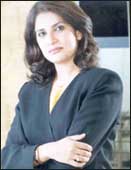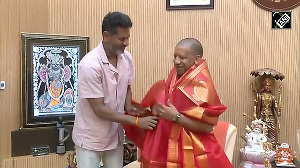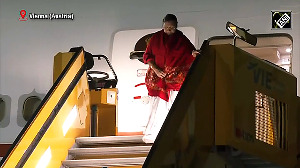After ruling the Indian scooter scenario for a long period, Kinetic Motors is changing gears. It now wants to foray into the much-hyped and highly competitive motorcycles segment.
With already well-entrenched players like Bajaj Auto, Royal Enfield and Hero Honda, it isn't an easy task.
But Sulajja Firodia Motwani, Joint Managing Director, Kinetic Motors is determined to transform the company.
Motorcycles is where the growth and the revenue is and she can smell that. Moving in aggressively, in the last three months Kinetic Motors announced the launch of four new bikes across the four segments of the motorcycles market. The announcement shook up the incumbents and injected new momentum in the market.
In an interview with Priya Ganapati, Motwani discusses her assessment of the market, the brand identity of Kinetic Motors and her plans for the future.
 In the last three months itself you have announced the launch of four new models. What is the strategy here? Are you looking to unsettle the competition?
In the last three months itself you have announced the launch of four new models. What is the strategy here? Are you looking to unsettle the competition?
The strategy was to make a bold and dramatic move by launching, simultaneously, four new motorcycles. With this, the company is present in every important category of motorcycles -- from economy (Boss 115) to executive (Velocity) and performance (GF 170 city) to premium (GF Laser).
A simultaneous launch of four motorcycles is a gutsy move and I believe it has made everyone sit up and take notice of us and driven a lot of traffic to our showrooms across the country
The Velocity has been the first of the four to hit the market. What is unique about this model?
Velocity aims to satisfy every need of an urban commuter. The executive bikes segment is the largest in the country with over 25 lakh motorcycles sold per year. It is seen as a commuter vehicles segment with vehicles that combine good styling and performance with high fuel economy and affordability.
Velocity offers all that and more. It has a modern and stylish look with a large and robust petrol tank. It is powered by a powerful and refined, smooth 115cc four-stroke engine that gives 8.5 bhp power. It gives a mileage of 92 kmpl.
The bike has complete instrumentation with a tachometer, throttle sensor with power and economy modes for riding guidance, a heat shield on the silencer, a pass light and a centralised handle lock.
So, in all it is a very complete offering in terms of design, features and performance. It is also priced very attractively at an introductory price of Rs 38,300. The positioning for Velocity is "Rule The City" -- its being marketed as a city bike.
How do you assess the two-wheeler industry in India and what do you see as the drivers for growth of motorcycles specifically?
Currently, the two-wheeler industry in India is very healthy and growing at a good rate. It is estimated that annually 5 million vehicles are sold in the country, which makes it the second largest two-wheeler market in the world -- next only to China, and tipped to grow at an estimated 16 per cent in the next 3 years.
Today, four-stroke motorcycles and modern (gearless, electric start) scooters and scooterettes are the vehicles of choice for the consumer. Geared scooters, which were very popular a few years ago have lost their appeal now.
I expect that this trend will continue. Motorcycles and modern scooters will see growth, and other categories will decline.
In motorcycles, there is tremendous competition and innovation, which will further fuel growth and we will see a lot of customers upgrading to faster, more stylish bikes.
Four-stroke bikes are popular as they are very fuel efficient and also good in rural areas where the roads are poor and ruggedness is required. Modern scooters are popular in urban areas since they offer tremendous comfort and convenience in congested city traffic conditions. There is no hassle of gear changing, storage space is available and it has universal appeal.
Kinetic Motors' decision to enter the motorcycle segment has been a fairly recent one. Why did you decide to shift the focus on motorcycles and what kind of challenges have you faced so far?
We could not enter the motorcycles segment earlier because of a restrictive joint venture with Honda Motors, Japan, which prevented us from making motorcycles as they had a JV (joint venture) with Hero to make the same.
But it was evident that motorcycles were to be the product category with maximum potential.
Today it accounts for nearly 70 per cent of all two-wheeler sales in India. And we did not want to miss this opportunity for growth -- which is why we bought out Honda's majority shareholding in our joint venture and started working on our product portfolio development.
We have signed a technical collaboration with Hyosung Motors, Korea for motorcycles with advanced technology like the V-twin cruiser Aquila, and the four valve GF series like GF 170city and GF Laser.
The challenge has been to make a shift in our image. Kinetic is a superbrand in modern scooters. We pioneered this segment in the two-wheeler industry.
In fact, the brand Kinetic also became generic to this product category to the extent that even in motocross circuits, there are automatic scooter racing categories that are named "Kinetic".
This brand identity has stayed with Kinetic over many years. Research has shown us that the association of Kinetic with modern scooters remains very strong. But there are of course positive and negative sides.
While Kinetic is seen as a pioneering and innovative company that cares about its customers, the challenge is to move beyond the strong brand association and to establish itself as a strong motorcycles manufacturer.
How has Kinetic benefited from this shift to the motorcycles segment?
It brings to us an opportunity for growth. We become part of the largest segment in the two-wheeler industry so there is definitely scope for major growth in sales volumes. It is also an opportunity to improve profitability. Traditionally, Kinetic engineering has made mopeds, and motorcycles definitely offer better contribution to the bottom line.
What do you see as Kinetic's brand identity today?
We are seen as an innovative, modern, high-tech and customer focused brand. We have over 50 lakh vehicles on the road. Our brand equity has been very closely aligned with modern scooters, but now with our aggressive moves, we are getting recognition as a motorcycle manufacturer too.
For bikes, we are creating a separate umbrella brand called "Kinetic Biking". Kinetic Biking is a sub brand of Kinetic that will capture the enthusiasm and passion that motorcycling commands for its customers.
With a wide range of motorcycles in every category, Kinetic Biking will provide a motorcycle for all people and all needs.
Overall positioning will come through our product design and performance as well as our communication. For example, our newly launched -- Velocity and the GF -- are both breakthrough bikes in the market.
We recently ran a full corporate campaign that highlighted how we have a product suitable for every customer's requirements. We also sport anew corporate logo.
Today what percentage of your sales comes from motorcycles?
Currently, about 25 per cent of our sales come from motorcycles and majority from scooters and scooterettes.
In motorcycles, our market share is quite small at 1.5-2 per cent. I am targeting in the next year, with the launch of four new motorcycles, a share of 5 per cent and over the next three years, I would like to take it to 10 per cent. This will come from the new products, entry into high volume segments and a continued focus on customer satisfaction.
For the next three years, what will be your priorities and which are the areas of concern for you?
For the next three years my priorities are to establish ourselves as a strong motorcycle manufacturer, retain our lead in modern scooters and scooterettes.
I want to reach a turnover of Rs 2000 crores. The concern is that it's a very competitive market today and we always have to be on the move.
You have consistently been feted as one of the key women business leaders in India? What kind of challenges does being both a woman and a business leader bring and how do you tackle them?
In all honesty I don't really think of myself as a 'woman' business leader. I am a professional, and I conduct myself as that.
I have never really faced any difficulty based on my gender. As for being a leader, I see myself more as part of a team.
I am a team player, I am democratic and take in a lot of feedback and suggestions from everyone.
The only real challenge is leaving my three-year old son Sidhant every day when come for work! Thankfully, I have an incredibly supportive husband, mother and parents-in-law.





 © 2025
© 2025